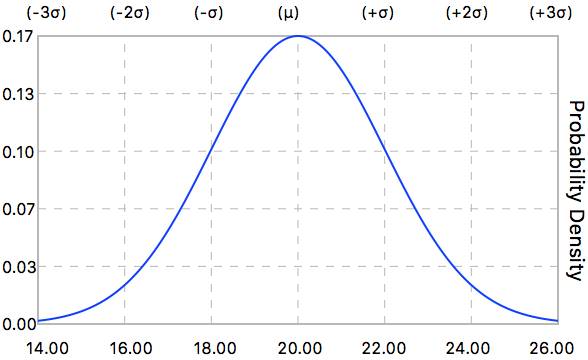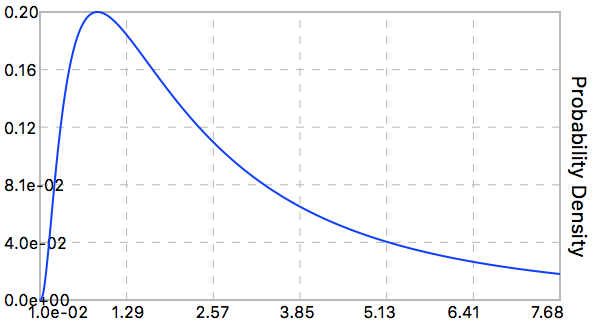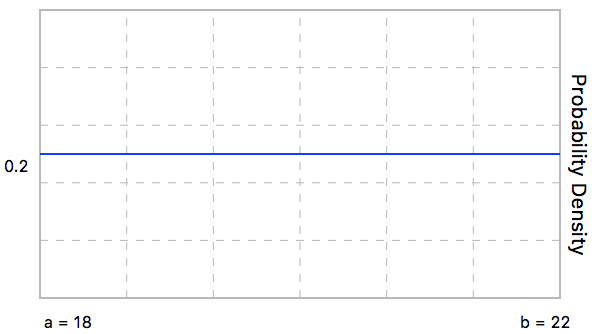6.4 Probabilistic / Sensitivity Analysis
Statistical Distributions
The following types of statistical distributions can be assigned to various material and reinforcement parameters for probabilistic analysis. Material parameters include unit weight, cohesion, friction, ru, B-bar, and the strength with depth and anisotropic parameters. Reinforcement parameters include tensile, shear, and pullout resistance parameters, spacing, bond length, and area coverage.
Note: All values generated by statistical distributions are limited to a lower bound value of 0 regardless.
Normal Distribution
The normal distribution takes the form of the "bell curve" shown below, and is defined by the mean (μ) and standard deviation (σ) of the random variable. Approximately 99.7% of values drawn from the normal distribution fall within 3 standard deviations of the mean.
The normal distribution is limited in between the minimum (a) and maximum (b) values specified.
 A random value (X) is generated from the normal distribution using the following equation:
A random value (X) is generated from the normal distribution using the following equation:

Log-Normal Distribution
The log-normal distribution is defined for a random variable whose logarithm is normally distributed. It can be useful to model random variables (such as cohesion and pore pressure) which may have a peak in probability density near zero and gradually taper off for larger values. It is defined by the mean (μ) and standard deviation (σ) of the random variable.
The log-normal distribution is limited in between the minimum (a) and maximum (b) values specified.
 A random value (X) is generated from the log-normal distribution using the following equation:
A random value (X) is generated from the log-normal distribution using the following equation:

Uniform Distribution
The uniform distribution takes the form of the rectangle shown below, and is defined by a lower value 'a' and upper value 'b', where all values within this range are equally probable. The probability density is defined as 1 / (b - a).
 A random value (X) is generated from the uniform distribution using the following equation:
A random value (X) is generated from the uniform distribution using the following equation:

Monte Carlo Analysis
After a standard analysis has been completed using deterministic material parameters, a Monte Carlo probabilistic analysis can be completed for the current selected trial by selecting Probabilistic from the analysis results table.
The Monte Carlo analysis generates and calculates the FOS for the specified # of Trials using the currently selected slip surface. For each trial unique values for every random variable are generated from their associated statistical distributions.
The probability that the FOS is less than a specified value is defined as follows, where x is specified by the user:
from the analysis results table.
The Monte Carlo analysis generates and calculates the FOS for the specified # of Trials using the currently selected slip surface. For each trial unique values for every random variable are generated from their associated statistical distributions.
The probability that the FOS is less than a specified value is defined as follows, where x is specified by the user:
 Note: Parameters with the
Note: Parameters with the  icon activated (in blue) in the material / reinforcement editors are included as random variables in the probabilistic analysis. All other parameters are maintained at their deterministic values for the analysis.
Once the calculations are complete, select FOS Probability Distribution from the Probabilistic menu to view the distribution of FOS calculated for the random variables.
icon activated (in blue) in the material / reinforcement editors are included as random variables in the probabilistic analysis. All other parameters are maintained at their deterministic values for the analysis.
Once the calculations are complete, select FOS Probability Distribution from the Probabilistic menu to view the distribution of FOS calculated for the random variables.
Sensitivity Analysis
After a standard analysis has been completed using deterministic material parameters, a sensitivity analysis can be completed for the current selected trial by selecting Sensitivity  from the analysis results table.
A sensitivity analysis is essentially a Monte Carlo probabilistic analysis, however only the single Variable specified is altered, while all others are maintained at their deterministic values.
The sensitivity analysis generates and calculates the FOS for the specified # of Trials using the currently selected slip surface. For each trial unique values for the selected random variable are generated from the associated statistical distribution.
Once the calculations are complete, select FOS Sensitivity Plot from the Sensitivity
from the analysis results table.
A sensitivity analysis is essentially a Monte Carlo probabilistic analysis, however only the single Variable specified is altered, while all others are maintained at their deterministic values.
The sensitivity analysis generates and calculates the FOS for the specified # of Trials using the currently selected slip surface. For each trial unique values for the selected random variable are generated from the associated statistical distribution.
Once the calculations are complete, select FOS Sensitivity Plot from the Sensitivity  menu to view the distribution of FOS calculated for the specified variable.
Specifying the Sensitivity FOS highlights the value of the sensitivity variable that corresponds to that FOS in the FOS Sensitivity Plot.
menu to view the distribution of FOS calculated for the specified variable.
Specifying the Sensitivity FOS highlights the value of the sensitivity variable that corresponds to that FOS in the FOS Sensitivity Plot.






